 valleedulot.com - The lot Valley - Outstanding villages
valleedulot.com - The lot Valley - Outstanding villages
Observatoiredes crues La vie de
la rivière Virtual visits French version English version

Back to home| What to do in the Lot Valley | Visits | Outstanding villages
Outstanding villages
Most beautiful villages in the Lot Valley
Some 32,000 villages have shaped the French countryside over time and those of them that are members of the Association "Les Plus Beaux Villages de France" (The Most Beautiful Villages of France) share the same passion and ambition : to make the exceptional quality of their heritage known and recognized and to invite you to encounter their history, their land, their culture and their inhabitants. Out of the 157 listed by the association, 10 are in the Lot Valley.
More information on http://www.les-plus-beaux-villages-de-france.org/en
Lot-et-Garonne
Monflanquin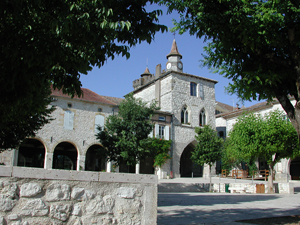
This "bastide" or fortified village was founded in 1256 and had to repress many attacks by the English and recover from the Wars of Religion. Although the village has lost is ramparts, it has retained its characteristic grid pattern and the ever-bustling Place des Arcades still displays some very fine houses, for example the house of the Black Prince.
Pujols
Perched on a hill overlooking the Lot valley, this old fortified village has managed to preserve its medieval character despite the passing of the years and wars : remains of the walls and castle, fortified gates, etc. Besides the charm of its white-fronted or half-timbered houses, the village boasts two religious buildings : the churches of Saint Nicolas and Sainte Foy which are both decorated with 16C frescoes.
Lot
Capdenac le Haut
Within a stone's throw from Figeac, the medieval fortress of Capdenac-le-Haut is built high up more than 110 meter above a meander of the Lot river. The village is also one of the most important Gallo-Roman site of the region, known as the seat of the last Caesar's battle in Gaul.
While you're here, visit the local museum :
Exhibition relating to prehistory, the Gallo-Roman era and the Middle Ages.
13th and 15th C. keep which houses two large rooms with loopholes and monumental fireplaces. Superb view from the terrace with its crenellations and corner towers.
Prehistory: a site of Neolithic occupation was found below the ramparts.
Gallo-Roman era: this site was for a long time considered to be the Uxellodunum referred to by Caesar, where the final battle in the military conquest of Gaul by the Romans took place.
Open from 1st July to 31st October .
Cardaillac
Cardaillac bears the name of one of the most powerful families in Quercy. The village’s distinctive feature and all that is left of medieval times is the fort with its two square towers and a round tower that provides a panoramic view of the village.
In Cardaillac as well, take some time to visit the museum :
This museum is different from most in that it takes the form of a tour to visit different old buildings and places around the village. As you explore one of its quarters, you come across the “sémalier”'s house (maker of items used in grape harvesting), the chestnut drying oven, the plum-dryer, the walnut-oil mill and press, the early 1900's classroom and the clog-maker's workshop.
Exhibition of old toys, sculptures, paintings and wrought-iron work.
Find out about the way of life of our ancestors in the places where they lived and worked.
Open from 1st July to 15th September
Saint Cirq Lapopie
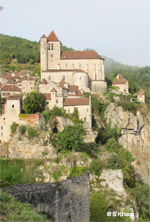 Saint-Cirq-Lapopie is perched on a cliff overlooking a meander of the Lot and is a masterpiece of medieval architecture. Surveyed by the fortified church, the houses with their sloping, brown-tiled roofs are a harmonious sight lining the picturesque alleyways. This spot has attracted both artists and writers such as André Breton who used to take up residence in the village in summer
Saint-Cirq-Lapopie is perched on a cliff overlooking a meander of the Lot and is a masterpiece of medieval architecture. Surveyed by the fortified church, the houses with their sloping, brown-tiled roofs are a harmonious sight lining the picturesque alleyways. This spot has attracted both artists and writers such as André Breton who used to take up residence in the village in summer
Aveyron
Conques
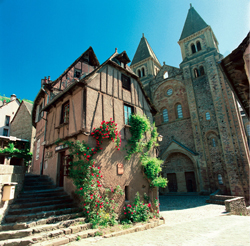
A small village that is labelled a Grand Site de France. In the heart of the Lot Valley, this key stopping place on the pilgrimage route to Santiago de Compostela conceals a wealth of treasures : half-timbered houses, the 11C and 12C abbey church of Sainte Foy, its 250 capitals, its contemporary stained-glass windows by Pierre Soulages and its tympanum with 124 sculpted figures depicting the Last Judgement, but also THE treasure, that of Sainte Foy, a golden statue covered in gold and precious stones.
Estaing
At the foot of the Aubrac Mountains, not far fromthe gorges of the Lot and Truyère, Estaing bears the name of a family of Lords one of whom became famous by saving the life of King Philippe-Auguste in Bouvines. The king then gave the village the right to display the royal fleurs-de-lys on its coat of arms. Shale stone houses with their "lauze" stone-slab roofs are nestled around a keep and castle dating back to the 12C and 15C and some of the finest town houses can still be seen.
Saint Côme d’Olt
In the Aveyron département but on the banks of the Lot, Saint-Côme-d’Olt was built behind the ditches of the old fortified town. The flamboyant gothic style church with its crooked spire, the Penitents’ Chapel and the Manor of the Sires of Calmont dating from the 12C stand alongside the old medieval stalls and the fine 15C and 16C houses to make a delightful combination.
Sainte Eulalie d’Olt
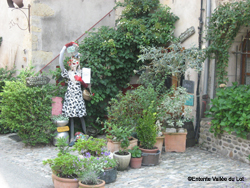 Sainte-Eulalie is on the right bank of the River Lot and the village is laid out in a succession of arcs around the church square, a church which is a masterpiece of Romanesque and gothic art. In the narrow streets paved with stones from the Lot, the houses date from the 15C to 18C and are lovingly bedecked with flowers by their inhabitants. The mills along the River Serre are a particular feature of the village and bear witness to the former crafts of tanning and drapery which used to use the water for power.
Sainte-Eulalie is on the right bank of the River Lot and the village is laid out in a succession of arcs around the church square, a church which is a masterpiece of Romanesque and gothic art. In the narrow streets paved with stones from the Lot, the houses date from the 15C to 18C and are lovingly bedecked with flowers by their inhabitants. The mills along the River Serre are a particular feature of the village and bear witness to the former crafts of tanning and drapery which used to use the water for power.
Lozère
Sainte Enimie
On the slopes of a canyon cut by the gorges of the Tarn, Sainte-Enimie sets out its massive limestone houses in tiers at the foot of an old Benedictine monastery, all that remains of which is a chapel and a chapter house. At its feet is Burle spring which is said to have cured the Merovingian princess Enimie of leprosy.
Sainte Eulalie d’Olt (Aveyron)
Well done to the inhabitants for restoring the half-timbered houses of their listed medieval town “one of the most beautiful villages in France”.
France”.
From the elegance of The Hôtel Renaissance to its 17th century mill the commune supports the spirit of the village and to revive the regional arts and crafts industry it founded the Small Arts School, with workshops open all year (with lessons and courses ).
Visit idea : come and watch a traditional horse-drawn caravan being made using the authentic methods. Atelier Les Roulottiers
More information on Saint-Eulalie d'Olt
Saint-Geniez d’Olt (Aveyron)
Formally a major hub for tanners and drapers, the village has preserved its 18th century hotels and prestigious religious monuments. The Augustins cloister and its 14th century chapel as well as the Pénitents-Noirs one of 17th century are a few examples. Nowadays, the town is famous for its strawberries.
Saint Côme d'Olt
Saint-Côme d’Olt nestles in a hollow in the Lot valley. Its almost circular tour de ville (circular street surrounding the village centre) and its ramparts, that have become the façades of the houses, give Saint-Côme d’Olt an exceptional appearance.
The heart of the village has kept its mediaeval character with its three fortified entrance gateways and its alleyways. Here you will find the manor of the Sires de Calmont built in the 12th century that boasts two imposing 14th century towers but also two monuments listed as historic monuments: the château de Castelnau, dating from the 13th century and today housing the Mairie as well as the Chapelle des Pénitents, formerly a hospice for pilgrims and now an exhibition room.
Visit Saint Côme d'Olt
Bozouls canyon
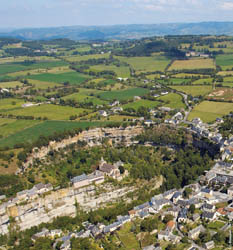 The “Trou de Bozouls” is a natural arena, a horseshoe-shaped canyon an impressive 400 metres wide and 100 metres deep, carved in the secondary limestone of the Causse Comtal. At the bottom of runs a modest torrent called the Dourdou, sometimes calmly, sometimes more impetuously.
The “Trou de Bozouls” is a natural arena, a horseshoe-shaped canyon an impressive 400 metres wide and 100 metres deep, carved in the secondary limestone of the Causse Comtal. At the bottom of runs a modest torrent called the Dourdou, sometimes calmly, sometimes more impetuously.Legend has it that the devil, seeking vengeance on the Lord and the Virgin Mary dug this hole night after night so that the church would collapse… It seems more probable that the Dourdou, over thousands of years, carved out this gigantic slice, whose flanks are lined with cracks that release water during heavy rain. The most famous of these is the Source des Fées on the right bank.
Travel from Entraygues to Espalion : Left bank, right bank of the Lot, these character villages leave their mark. You'll appreciate the old tanneries, the Vieux Palais d'Espalion, the beautiful houses and the College around the Estaing castle or even the medieval bridges and the chapel of Notre-Dame du Portet d'Entraygues.
The Valley of Célé (Lot)
Marcilhac-sur-Célé
overlooked by cliffs, a fine collection of Renaissance houses, snuggling around a Benedictine abbey church in ruins : back in the 11th century it was almost as important as Conques!
Espagnac-Sainte-Eulalie
former priory from the 13th century and its wooden bell tower really adds to the charm of the village, giving it the air of a little paradise. Stopover gite for the jacquaire pilgrims in the priory.
In the surroundings area : Musée de l'Insolite (museum of the unusual) at Cabrerets www.museedelinsolite.com
The Truyère Gorges of the Pays d'Olt
Le Malzieu (Lozere)
This stronghold is a real gem with its fortifications flanked by towers, its medieval houses and its romanesque chapel. A ideal base for you : eco-tourists!
Mur-de-Barrez (Aveyron)
Former fiefdom of the princes of Monaco, it has kept its narrow little streets, its medieval houses and its fortified towers. To explore : the dream footpath, set to the rhythm of artistic creations
Close by :
The Garabit Viaduc (Cantal)
built by Eiffel in 1882, just before he built the Tower! Guided tours with the Margeride Ecomuseums.
From Laguiole (Aveyron), a village famous for its knives and its factory, reviewed and remodelled by Philippe Starck, we go on to reach Nasbinals (Lozere) and Saint-Urcize (Cantal) where we visit their Romanesque churches, passing along the way throughout the village of Aubrac (Lozere), which is one of the stages along the Saint James way.
Marcolès
Situated on a jacquaire path, it still boasts some medieval and Renaissance homes, which you can explore as you make your way along the carrierons, which are typical little streets. Artists’and craftsmen’s workshops.
Website www.marcoles.fr
Maurs
Founded in the 10th century, a round city, full of charm, baptised "the Nice of Cantal" for its micro-climate. What you should see : the Saint-Césaire Abbey church and its reliquary and the horse fairs, in May and October, famous throughout the Midi-Pyrénées.
Website www.chataigneraie-cantal.com
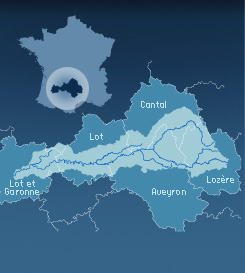
 :
: 




